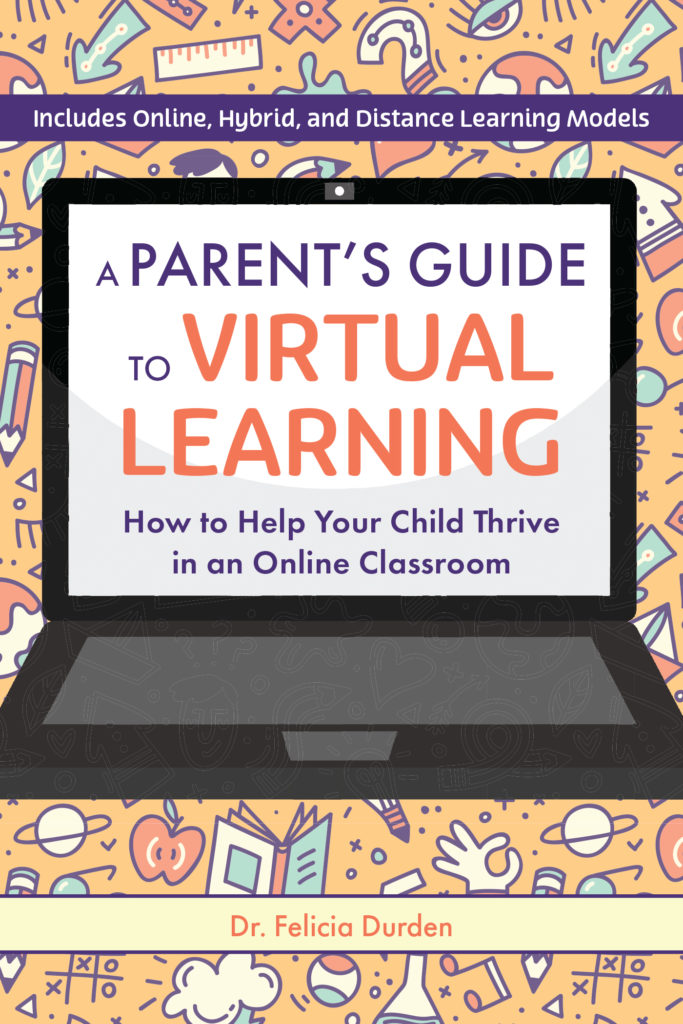
Help Your Child Succeed with A Parent’s Guide to Virtual Learning
- Book Sample /
- Education
 If you have kids, you know that the past year of school has been challenging, to say the least. Virtual learning on multiple platforms has been stressful not only for the students, but for the parents who now need to help facilitate their child’s education. In this current education landscape, parents need just as much guidance into our “new normal” as their children.
If you have kids, you know that the past year of school has been challenging, to say the least. Virtual learning on multiple platforms has been stressful not only for the students, but for the parents who now need to help facilitate their child’s education. In this current education landscape, parents need just as much guidance into our “new normal” as their children.
Dr. Felicia Durden, an accomplished educator with more than 20 years of teaching experience, provides this much-needed guidance in her new book, A Parent’s Guide to Virtual Learning. In this book, Dr. Durden shares her strong desire to provide families with tools to help their children succeed in school. She believes that as their child’s first teacher, it is important that parents are given tools and tips that will help them on their journey.
The following is an excerpt from A Parent’s Guide to Virtual Learning to help busy parents make sense of the types of virtual schooling their child may be faced with. If you want to learn more about digital education platforms, understand teaching strategies, and fully support your child’s education, order a copy of A Parent’s Guide to Virtual Learning today!
A Paren’t Guide to Virtual Learning Book Sample
Following are tips for the main virtual learning models I have seen used consistently. Again, these are not the only online models out there. Schools have some pretty creative ways to meet their students’ needs, but these are the scenarios that you are most likely to encounter.
Distance Learning
If your child’s school is using learning packets, here are some tips for you.
Make sure that you understand what the teacher expects students to complete and what they want turned in. For example, let’s say you are told that your child is expected to read for thirty minutes each day. You should ask what evidence the teacher wants to prove that they have done their reading.
If your child is using packets, make sure that they read the directions carefully or that you read them to make sure work is completed correctly. I don’t know how many times I’ve seen students complete a worksheet without reading the directions, and they circle all the words that rhyme with the wrong sound, for instance.
Another tip is to help your kids pace themselves if the packets are to be done over the course of a week. Set a time each day for your child to work on the packet and give them benchmark goals to accomplish each day. For example, if your child has a twenty-page packet, advise them to break it up and complete four pages each day. You don’t want your child rushing through all
the work at the end of the week right before the due date. That will be stressful for both you and your child.
If your child cannot complete the work because it’s too difficult for them, immediately reach out to the teacher and find out what your options are. Often teachers have alternative work packets, or possibly you can schedule some time for the teacher to talk with your child to provide guidance and tutoring.
Full Online Learning
When you’re working with a full online model, the first step is to make sure you test your computers and the programs that your child is asked to use. This can be one of the most frustrating things about being fully online: Your child is expected to log in at a certain time of the morning and your sign-in does not work. Does this sound familiar? Be on top of what the expectations are for  logging in, and you have accomplished half the battle of full online learning. This may sound like a simple tip, but believe me, a nonworking password can send you into a tailspin that can become an overwhelming burden over time.
logging in, and you have accomplished half the battle of full online learning. This may sound like a simple tip, but believe me, a nonworking password can send you into a tailspin that can become an overwhelming burden over time.
As with the learning packets, if your child is learning exclusively online, be sure to get a clear understanding of what is required to be completed each day. Some students will have exercises that they must finish independently after their teacher provides instruction. Many parents have noted that their kids had assignments to complete, but they were not aware of this until report cards came out and their child was marked down for not completing their work.
If you don’t remember anything else in this chapter, please remember to check in with your child’s teacher to ensure you are clear on what the expectations are. Many issues can be avoided simply by asking for clarification.
Seek clarification! The great thing about full virtual learning is that you can often get online with the teacher during instructional time to ask questions. Most schools will also have virtual office hours that you and your child can use to meet with the teacher if you are experiencing any issues.
Hybrid Models
The nice thing about this model is that on the days your child is in school, they can get support and questions answered about areas that they may be struggling with. The downside is that students can have a hard time being home and working online after being in the classroom with their teacher and peers the day before. In this section, I will provide some ideas on how to make the days you work together at home seamless.
areas that they may be struggling with. The downside is that students can have a hard time being home and working online after being in the classroom with their teacher and peers the day before. In this section, I will provide some ideas on how to make the days you work together at home seamless.
In the hybrid model, you will use the same online learning support tips that are listed above for the days/times your child is working from home.
To seamlessly transition your child from being at school to working online at home is to set defined boundaries and clearly explain to your child that the same expectations apply whether they work at school or at home. Many children find it hard to grasp schooling at home while in the home setting. Home is home, so they might begin to exhibit behavior that is not “school-like” in the house. Nip this in the bud immediately by stating clearly to your child in terms that they can understand that on the days they work from home, they are still in school. This one tip will save you from so many power struggles between you and your child when it comes to understanding the expectations. It again is a simple thing to do that will yield a huge harvest. Below are the steps to follow to explain and set the expectations with your child:
Closing Thoughts on Virtual Learning
The first thing I am going to ask you to do before going any further in this book is to give yourself some grace. We live in a world of comparison. Facebook, Instagram, and Pinterest don’t make life easy. Don’t buy into the perfection monster, but know that you are doing your best each and every day, and by reading this book and those like it, you are taking phenomenal steps to help make virtual learning a positive experience for your family. I want to congratulate you for the care and effort you are putting into your child’s education. Don’t worry, don’t compare, and don’t buy into perfection. Give yourself some grace, and let’s do this!





